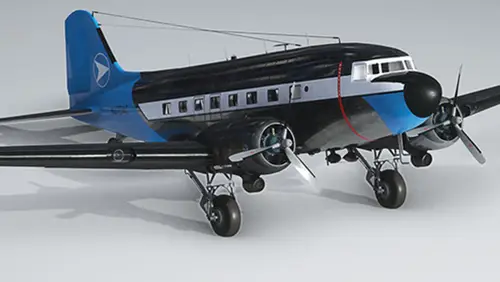NOTE: A free upgrade for PC is available in the Marketplace.
The DC-3 is a twin-engine, low-wing, propeller-driven airliner developed and produced by the Douglas Aircraft Company of the United States. The DC-3 (Douglas Commercial 3) is one of the great legends of the history of aviation as it revolutionized the air transport industry by enabling air carriers to operate profitably. The DC-3 took its maiden flight in 1935 and more than 10,000 were eventually produced.
The Golden Age of Flight, the period between World War I and World War II, witnessed the nascent aircraft industry make enormous strides in advancing the performance of aircraft of all types, from military to specialized racers. Commercial aviation represented one of the great prospects during this time of heated development. The problem for commercial aviation at this time was that aircraft carried too few passengers and cargo to be profitable. This changed as a result of the president of American Airlines requesting that Douglas Aircraft create a larger, more luxurious airplane than any that existed at the time. Douglas created the DST, the Douglas Sleeper Transport. First flown on December 17, 1935, the DST comprised fourteen luxury sleeper berths for high-end passengers. The “day” version, called the DC-3, had 21 seats. The DST/DC-3 was an all-metal design and featured retractable landing gear, two sets of instruments, and an autopilot.
The airframe quickly proved to be a great success, with the day version going into high production. For the first time, airlines could operate profitably, and without government subsidies. By 1938, the DC-3 accounted for 95 percent of all commercial airline traffic; by 1939, 90 percent of the entire world’s commercial air traffic flew on the DC-3. During World War II, the United States and the Allies used a modified version of the DC-3, designated the C-47, extensively. The C-47 participated in all major campaigns of World War II, proving the critical logistical factor in a number of them. In all, 803 commercial versions of the DC-3 and 10,123 military variants took to the sky. Russia built an additional 3,000 under license, designated the airframe the Li-2, and Japan built 500.
The DC-3 measures 64 feet, 8 inches in length, stands 16 feet, 11 inches tall, and has a wingspan of 95 feet, 2 inches. The aircraft is powered by two 1,200-horsepower Pratt & Whitney R-1830-S1C3G Twin Wasp 14-cylinder radial engines turning 3-blade Hamilton Standard constant-speed propellers. The DC-3 has a range of 1,495 miles, a service ceiling of 20,800 feet above sea level, and a climb rate of 1,130 feet per minute. It cruises at 207 miles per hour and has a top speed of 230 mph.
Many aviation historians consider the Douglas DC-3 the most important aircraft ever produced due to its influence on both commercial and military flight. The combination of its consistent performance, long range, and forgiving handling in a wide range of conditions has endeared it as an aviator’s favorite.






















